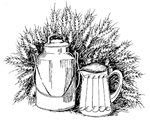
NUTRITION 101: LESSON TWO
CARBOHYDRATE:
Carbohydrates are organic compounds of carbon, hydrogen and oxygen in which, with few exceptions, the ratio of Hydrogen to Oxygen is 2:1. The body uses Carbohydrates as a source of energy and heat. Plants take in carbon dioxide from the air, capture energy from the sun in molecules of chlorophyll and, through a complicated process called photosynthesis, make large chain-like units of saccharides (sugar molecules) called starch and cellulose. Starches are long chains of glucose saccharides
Types of carbohydrate:
The number of links of sugar molecules in a chain determines the type of carbohydrate. Polysaccharides are made up of many saccharides strung together. Oligosaccharides consist of 3-15 sugar molecules. Disaccharides consist of two sugar molecules and monosaccharides consist of single sugar molecules. These various forms of saccharides are present in both plants and animals. Polysaccharides make up starch and fiber. A type of oligosaccharide is maltodextrin which is often used in the processing of powdered food supplements. An example of a disaccharide is the milk sugar lactose and the common table sugar sucrose. Common monosaccharides are fructose found in fruit and vegetables and the blood sugar glucose.
Cellulose is a polysaccharide carbohydrate composed of units of glucose linked together by lignans. Lignans are chemical compounds composed of two or more phenylpropanoid units which are plant derived organic compounds that are biosynthesized from the amino acid phenylalanine and provide many protective functions for the body. The body does not digest cellulose but uses it as fiber to facilitate elimination of waste through the bowel. Since cellulose is the main constituent of the cell walls of plants, it is found in most plants but is often removed in food processing. Cellulose is found in abundance in grains and flex seed has the highest levels of lignans.
Digestion of carbohydrate:
When you eat a meal, the carbohydrate from that meal begins to digest in the mouth due to the action of an enzyme called salivary amylase. Such partially digested carbohydrate then passes through the stomach to the small intestine where various enzymes from the pancreas complete the breakdown of complex carbohydrate (Starch) into simple carbohydrate such as the blood sugar glucose. Glucose enters the blood stream and passes into cells through the action of insulin from the beta cells of the pancreas and help from the trace mineral chromium Insulin will convert excess glucose into stored carbohydrate called glycogen. Glycogen is stored in the liver and muscle tissue and is released and reconverted to glucose as the body needs it. The monosaccharide fructose, goes directly to the liver where it is converted to glycogen and triglyceride fat.
There are two basic types of starch in foods. One is called amylose and the other amylopectin. The ratio of one to the other in a food has a direct affect on the speed at which such food will break down into glucose. Amylose is a straight chain of glucose molecules tightly bound together and therefore hard to gelatinize which results in slower digestion of the starch. Amylopectin is a string of glucose molecules with lots of branching chains which results in a starch that is easier to gelatinize and therefore, more easy to digest.
Gelatinization is where water and heat expand the starch granules to where there is created much larger surface areas to which digestive enzymes can attach and, therefore, speed up the process of breaking down the polysaccharides into disaccharides and finally into the monosaccharides of glucose, fructose and galactose.
Foods which have little amylose but have lots of amylopectin digest faster and, therefore, raise blood sugar faster. Refined wheat flour is an example of a high amylopectin carbohydrate. Because of the very small particle size of this flour, it is easy for water to be absorbed. This adsorption of water greatly expands the surface area of each particle. This expansion makes it easy for enzymes to break down this flour in the digestive tract. The removal of the fiber during the refining process contributes further to gelatinization. Basmati rice and most beans have a lot of amylose and therefore are examples of foods which digest slower and therefore raise blood sugar at a slower rate. Pasta that is made from durum wheat (semolina flour) will generally digest slower because durum wheat is very hard when milled. This results in larger particles with less gelatinization (swelling) and therefore slower digestion.
A note about fructose:
Fructose is naturally found in fruit, therefore its name. The fructose being used by the food industry is not derived from fruit as that would be much too expensive. Commercially used fructose is instead derived from corn syrup and in reality is a blend of 55 percent fructose and 45 percent glucose. While the fructose does not immediately convert to glucose, the glucose in this blend will raise blood sugar quickly and therefore must be processed out of the blood by insulin. Substituting fructose for sucrose is not improving things very much.
In addition to being converted to glycogen, fructose also stimulates the liver to produce triglycerides. In research done with feeding men a high glucose or a high fructose diet, it was the high fructose diet that led to significantly higher triglyceride levels in the blood. Fructose converts to fat more readily than any other sugar. Other research has shown that fructose caused an increase in serum cholesterol and low density lipoproteins (LDL). Fructose ingestion increases uric acid levels which can lead to inflammatory problems.
It should be apparent that fructose from corn syrup is not the answer to improving blood sugar control. When fructose is analyzed relative to its fat generating effect, we have even more reason to avoid it. Fructose found in fruit and vegetables is present in small amounts and is combined with fiber and a variety of nutrients. This is the way you should eat your fructose.